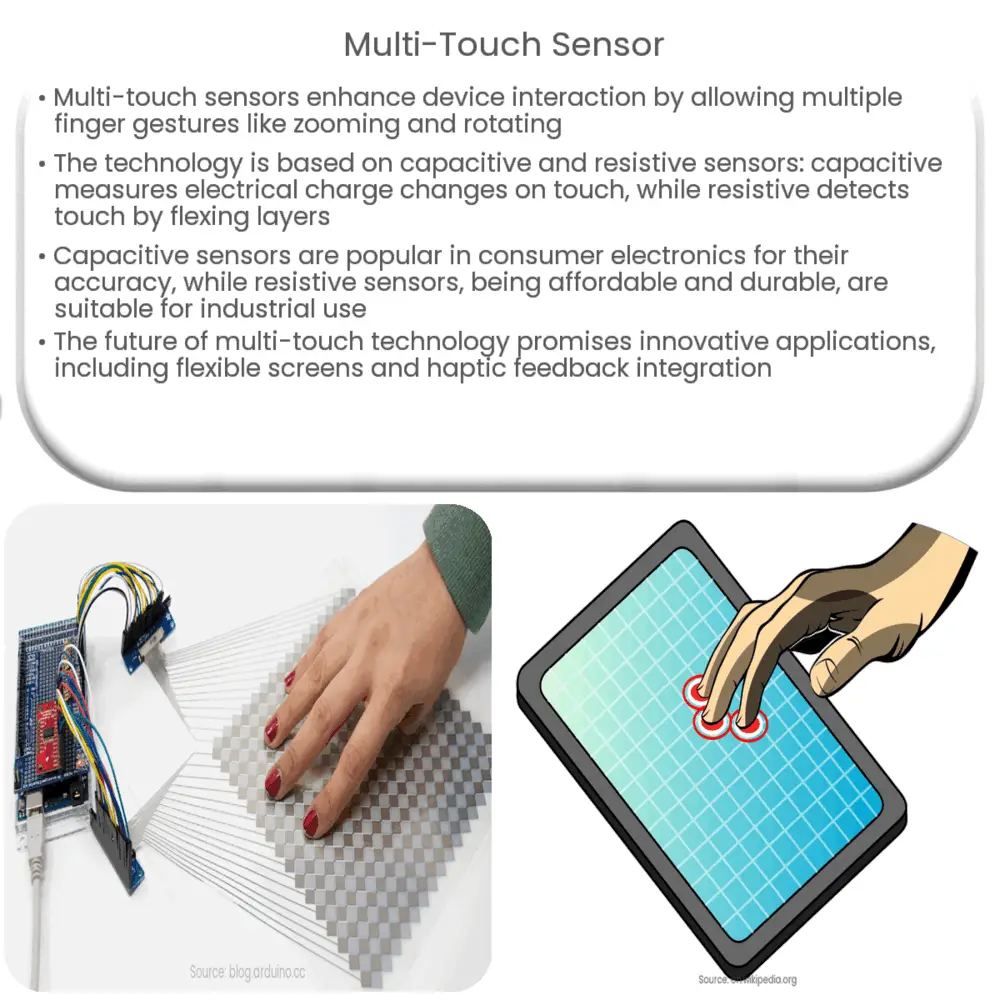Explore the fascinating world of multi-touch sensors, their workings, applications, and the exciting future that awaits this transformative technology.

Understanding Multi-Touch Sensors
Multi-touch sensors have become a crucial component of modern technology, enhancing the way we interact with our devices. These sensors, in essence, allow users to use more than one finger at a time on a touch-sensitive screen, facilitating actions such as zooming, rotating, and more complex gestures.
The Mechanics of Multi-Touch Technology
Multi-touch technology is primarily based on two sensor mechanisms: capacitive and resistive. Capacitive sensors work by measuring the change in an electrical charge on the screen’s surface. When a user’s finger, which is naturally conductive, touches the screen, it disrupts the device’s electrical field and alters the charge at the point of contact. This change is registered as a touch input. On the other hand, Resistive sensors consist of multiple layers that flex upon touch. When these layers come into contact, the touch point is registered.
Capacitive Multi-Touch Sensors
Capacitive sensors are popular in consumer electronics due to their sensitivity and accuracy. They use a layer of capacitive material to hold an electrical charge; when you touch the screen, you change the amount of charge at a specific point. This technology supports multi-touch because it can detect and isolate multiple points of contact.
- Projected Capacitive Touch (PCT): PCT technology supports multi-touch by using a grid of sensors embedded in the screen. This allows the screen to detect multiple fingers at once, even if they are close together.
- Surface Capacitive Touch (SCT): SCT technology uses sensors at the corners of the screen and a thin evenly spread conductive layer to detect touch. However, it typically does not support multi-touch.
Resistive Multi-Touch Sensors
Resistive multi-touch sensors are less common in consumer devices due to their lack of support for complex multi-touch gestures. However, they are more affordable and durable, making them suitable for industrial and heavy-duty applications.
- 5-Wire Resistive: This is the most common type of resistive touch technology. It uses a flexible top layer and a rigid bottom layer separated by spacers. When the screen is touched, the top layer flexes to come into contact with the bottom layer, registering the touch.
Applications of Multi-Touch Sensors
Multi-touch sensors have found their way into a wide range of devices, revolutionizing the way we interact with technology. Here are some of their key applications:
- Smartphones and Tablets: These are the most common devices that utilize multi-touch technology. From pinch-to-zoom to multi-finger swipes, multi-touch has made mobile device use more intuitive and efficient.
- Laptops: Many modern laptops come with multi-touch trackpads, allowing users to scroll, zoom, and navigate with ease.
- Gaming: Multi-touch screens have also entered the gaming world, offering a more interactive and engaging user experience.
- Industrial Applications: Resistive multi-touch sensors are often used in rugged environments due to their durability and affordability. These include kiosks, ATMs, and other heavy-duty applications.
The Future of Multi-Touch Sensors
As technology advances, we can expect to see more innovative applications and improvements in multi-touch sensors. For example, the development of flexible and foldable screens could see the implementation of multi-touch technology in new formats and devices. Additionally, the integration of haptic feedback technology could create more immersive and tactile interactions, enhancing the user experience even further.
Conclusion
Multi-touch sensors have undeniably transformed the way we interact with our devices, making technology more intuitive and user-friendly. As we continue to innovate and explore new possibilities, the future of multi-touch technology promises to be even more exciting, with advancements that could redefine our interaction with the digital world. Whether it’s in the realm of personal devices, gaming, or industrial applications, the impact of multi-touch sensors is immense and far-reaching.

